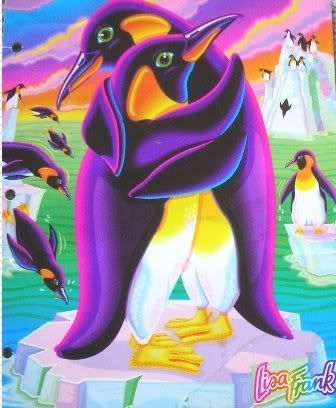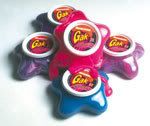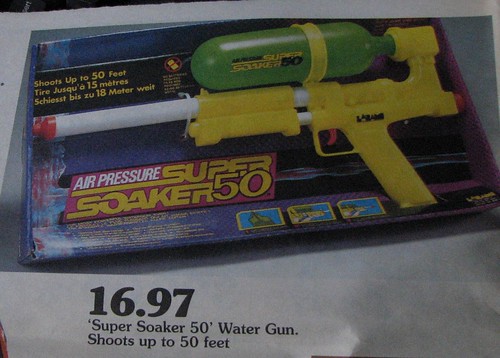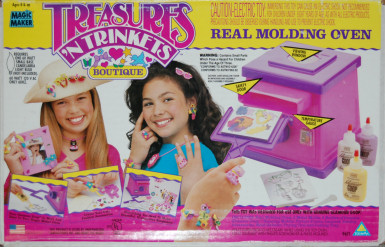
What exactly about the birthing process do toy companies perceive to be so child-friendly? Aside from the fact that labor begets a child, that is. Children are both innocent and inquisitive, and parents have a hell of a time balancing those two conflicting natures without sadistic toy manufacturers coming in and mucking it up with biologically confusing playthings.
In the late 80s and early 90s, Hasbro came up with a glorious marketing scheme guaranteed to disappoint one in five children. "What if we had this animal doll," a Hasbro rep would suggest excitedly. "That has babies inside of it?" The guy at the head of the table would clasp and unclasp his hands, asking thoughtfully, "But how would the children extract the babies?"
A fine question indeed, guy at the head of the table. I'll tell you how. In a natural order-defying act of toy bizarreness, the good people of Hasbro developed a velcro-adhered pouch that children could simply open and close as they please. As you can imagine, this led to inevitable confusion about birthing. A whole slew of Puppy Surprise-toting kids spent years thinking that when you're done playing with a baby, you can simply shove it back into the womb. No problem here.
The "surprise" element of Puppy Surprise referred to the fact that the doll could contain three, four, or five puppies. Kids are fairly simple creatures, and are thus easy to persuade that more equals better. In fact, every child was convinced that as special as he or she was, it was only fair that their doll contained the maximum of five puppies. You can bet parents had a swell old time consoling these children when their doll (as most did) contained a scant three puppies.
Three puppies? Don't insult me, Hasbro. What can I do with three puppies? Five, now that's a fun toy. But three? Come on.
Note that sped-up fine-print speech at the end: "Puppy Surprise comes with three, four, or five baby puppies! One in five Mommy dolls comes with four or five puppy dolls." Luckily, children are terrible at math, or they'd realize they had a crappy 20% chance of achieving the maximum (or even silver medal) Puppy Surprise experience. They are, unfortunately, pretty adept at counting and thus are clearly aware when they are being cheated.
I remember a birthday party at which one of my classmates received a pink Puppy Surprise with five puppies. How was I supposed to compete with that when my spotty mommy doll had been significantly less fertile? This was the precise moment in a child's life when they learn that life is not fair. Luckily for parents, they also learn greed, envy, anger, and all sorts of other fun hard-to-quell negative behaviors. Thanks, Hasbro!
Fortunately, if you struck out the first time, there were approximately one million alternative variations you could subsequently beg for to try your luck of the litter again. All dolls in the Surprise line had similar by-the-books adorableness achieved by the winning combination of hard plastic faces and soft, pliable bodies. The box assures us that each of our babies, just like us, are unique. Unlike us, their uniqueness is broadcast by a ribbon round the neck declaring the puppy to be of the male or female persuasion.
Hasbro churned out all variations of huggable Surprise creatures including Kitties, Bunnies, Bear Cub, and Pony. Conveniently, in Hasbro world all of these animals and their corresponding offspring were roughly the same size. Lucky for us, the fun didn't stop there! As the ever-competitive toy market necessitates, Hasbro had to milk this concept until the Mommy Surprise ran dry. Let's investigate some of the odder exploits Hasbro undertook in order to continually surprise us:
Drink n' Surprise.
To those of us now immersed in semi-adulthood, this sounds like a typical weekend. Back in the early 90s, however, you would have been far happier to wake up to this surprise the next morning. In this case, if you shoved a tiny bottle of water down your puppy's throat, you could be rewarded with a variable physical reaction. As the tag-line said, "Will your puppy drink n' wet or drink n' burp?" If only we so excitedly anticipated these outcomes in human infants.
Surprise Outfit
These lucky pups came complete with a mysterious box that could contain any type of outfit. Just imagine! Sure, you only had three puppies to speak of, but that one comes dressed as a mermaid. Makes up for it, right?
Playful Hair Surprise
In essence, you yanked on the little guys' till their hair was visible, with blue hair indicating a male and pink a female. The hair could also be re-retracted (yep, two re-s) into the body. That certainly is...a surprise.
There were oodles more there those came from, but they all generally shared the same ridiculous elements of Surprise. There was always some element of unexpectedness that lent some excitement to the toy opening process. After that moment had passed, however, the doll lost quite a bit of its luster.
Unsurprisingly, Hasbro began releasing "sold separately" packs of babies for reasons we can only assume are related to the continuous bitching from the four in five kids whose dolls contained just three babies. Though children delighted in this manner of cheating the system, there was a fatal flaw in the system. The velcro-pouch wombs were just big enough to accommodate innumerable additions to the additional litter.
At least it gave us an easily identifiable means of judging whose parents were child-spoiling suckers: the ones whose Puppy Surprise dolls' painfully bulging bellies dragged on the floor. Served them right. I was stuck with three puppies, none of whom had retractable hair or a mermaid costume. The only thing to console me? My Mommy Doll got to keep her svelte pre-litter figure. In your face, kids whose parents buy supplemental toys to appease their obnoxious children. In your face!





































